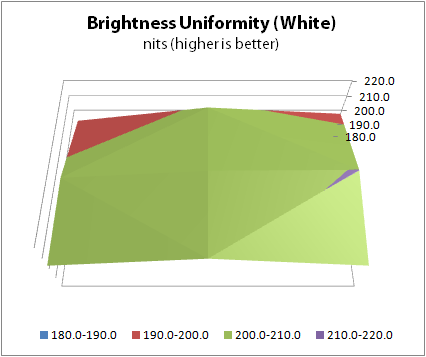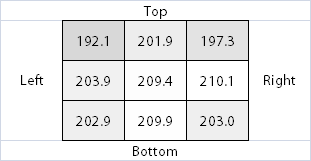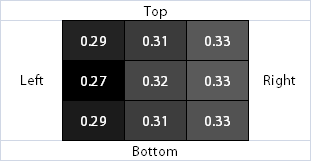A New 30" Contender: HP ZR30w Review
by Brian Klug on June 1, 2010 6:30 PM EST
Brightness Uniformity
In addition to the performance at center, we’ve also added 9-point testing for brightness, both white and black. This is done the same way we measure color uniformity, except we only care about measured intensity. We set the monitor through the "OSD controls" to near 200 nits, and then measure those 9 points.
White Level Uniformity
Black Level Uniformity
Our plots here do exaggerate differences - the ZR30w is remarkably uniform with an average brightness of 203 nits and a standard deviation of 6 nits. There’s a bit of a pattern for white, up top there’s a measured falloff compared to the rest of the panel, but visually I couldn’t discern any difference. It seems that under 10 nits is difficult to really discern.
Blacks are a similar story - they're very uniform. The average is 0.31 nits with a standard deviation of 0.019. There’s a slight brightness difference horizontally across the display, but again even after intense scrutiny I couldn’t discern anything. Brightness uniformity is impressive as expected.














95 Comments
View All Comments
Taft12 - Wednesday, June 2, 2010 - link
http://accessories.dell.com/sna/products/Docking_S...$150 CAD - if that's a tough sell, how did you convince them to buy you a monitor that costs over $1000?!
theangryintern - Thursday, June 3, 2010 - link
that's weird. We order docking stations with every single laptop we order. When people are in their office, they all want dual 22" displays.DigitalFreak - Tuesday, June 1, 2010 - link
I'm happy with my Dell U2410 and its HDMI, DVI x 2, Display Port, etc. inputs. :-)ghitz - Wednesday, June 2, 2010 - link
We're talking about 30" here!thorr2 - Tuesday, June 1, 2010 - link
I have the LG W3000H-Bn that I got from newegg. I am very happy with it although it is on the green side before calibration. It would be interesting to see a professional review of it to see how it compares to the others. It is definitely cheaper than a lot of the competition.zsero - Tuesday, June 1, 2010 - link
Sorry, but there is a big misunderstanding in this article:> I have no trouble believing that HP's claims about 1+ billion colors are totally accurate - you have to
> see it in person to believe it. There are just some colors I'm used to not seeing represented very
> well; reds and blues especially, and the photos that I have looked at are spectacular.
Color gamut and the number of colors are totally different things!
But what is _missing_ from the article is that:
1. Using 24 bit color (8-bit per color) with a calibrated display profile you get visible banding.
2. Using 30 bit color (10-bit per color) you can calibrate a monitor without visible banding.
3. For 30 bit color you need DisplayPort and a professional graphics card + driver + OS + software support. For example newest professional Nvidia Quadro or Matrox cards, with a good combination of software and OS!
4. What you have seen was less than 16 million colors, as you have used DVI and a calibrated output from a consumer graphics card.
5. The billion color thing is nothing but the good sounding fact that 2^30 > billion (actually it's 1 billion, 73 million, 741 thousand and 824)
Brian Klug - Tuesday, June 1, 2010 - link
I totally agree and I'm glad someone caught me ;) To be honest, I'm still a bit confused about the 32-bit color setting in windows in the display driver window and how that relates to the 30-bit claim. It would seem to me that 32-bit true color is indeed being driven, no? There's definitely no banding visible, at least from what I've scrutinized.I did space on trying DisplayPort though, I'm going to give that a shot in a second here and will probably update if I find something interesting! ;)
Cheers,
Brian
Brian Klug - Tuesday, June 1, 2010 - link
I now follow completely what you mean. I tried using DisplayPort and DVI both to pass 10-bit Deep Color to the ZR30w, but apparently that feature isn't implemented on the ATI HD5870. I'm hoping to try it on a 2010 MBP, but it'll be some time before my miniDP to DP adapter arrives so I can test.Until then, I'm not entirely sure what the status is, but realize this is an important concern and chief feature of the ZR30w. I'm going to continue to investigate. Honestly, I don't expect the gamut to change that much, but it would indeed be interesting to see if 10-bit deep color does work as advertised. I might need a better workstation card. I'll update when I find out.
Cheers and thanks!
Brian
prof.yustas - Tuesday, June 1, 2010 - link
Excellent. Thank you. In addition, it would be very useful to hear your take on the best 24-inch 16:10 (not 16:9) display out there, which is another way of asking for the DELL U2410 vs. HP ZR24w comparison.Mr Perfect - Wednesday, June 2, 2010 - link
http://www.tftcentral.co.uk/ has reviewed both, if you're interested.